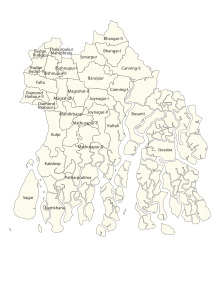Population
According to the 2011 Census of India, the Bhangar II CD block had a total population of 246,708, all of which were rural. There were 127,195 (52%) males and 119,513 (48%) females. There were 34,837 persons in the age range of 0 to 6 years. The Scheduled Castes numbered 48,893 (19.82%) and the Scheduled Tribes numbered 1,892 (0.77%). [9]
According to the 2001 Census of India, the Bhangar II CD block had a total population of 207,418, out of which 107,221 were males and 100,197 were females. The Bhangar II CD block registered a population growth of 24.60 per cent during the 1991-2001 decade. Decadal growth for the South 24 Parganas district was 20.89 per cent. Decadal growth in West Bengal was 17.84 per cent. The Scheduled castes at 48,005 formed around one-fourth the population. The Scheduled Tribes numbered 3,547. [10] [11] [12]
Large villages (with 4,000+ population) in the Bhangar II CD block (2011 census figures in brackets): Hat Gachha (5,882), Hadia (7,921), Dharmatala Pachuria (5,789), Swastayan Gachhi (6,966), Uriaparaur (4,893), Tona (8,914), Shyamnagar (5,078), Jaynagar (4,921), Naoabad (4,975), Pitha Pukuria (11,078), Jirangachhi (5,193), Benota (7,850), Chariswar (4,097), Bamunia (15,582), Saduli (4,230), Majherhat (7,797), Uttar Kasipur (10,782), Chandihat (5,272), Nanglapalpur (4,755), Bhogali (7,516), Nimkuria (5,604), Chalta Beria (4,167), Panapukur (5,770) and Uttar Kathalia (8,628). [9]
Other villages in the Bhangar II block include (2011 census figures in brackets): Sanpukuria (2,654). [9]
Literacy
According to the 2011 census, the total number of literate persons in the Bhangar II CD block was 157,734 (74.45% of the population over 6 years) out of which males numbered 85,372 (78.01% of the male population over 6 years) and females numbered 72,362 (70.64% of the female population over 6 years). The gender disparity (the difference between female and male literacy rates) was 7.37%. Gender disparity in literacy in the Bhangar II CD block was the lowest amongst all CD blocks in South 24 Parganas district. [9]
According to the 2011 Census of India, literacy in the South 24 Parganas district was 77.51 [13] Literacy in West Bengal was 77.08% in 2011. [14] Literacy in India in 2011 was 74.04%. [14]
According to the 2001 Census of India, Bhangar II CD block had a total literacy of 65.65 per cent for the 6+ age group. While male literacy was 72.89 per cent female literacy was 57.78 per cent. South 24 Parganas district had a total literacy of 69.45 per cent, male literacy being 79.19 per cent and female literacy being 59.01 per cent. [10]
See also – List of West Bengal districts ranked by literacy rate





















